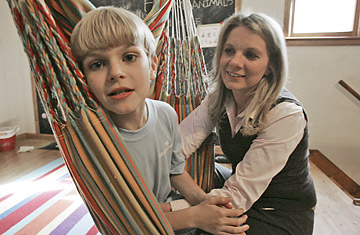
Ten year-old Tristan Bonnert, who has autism, with his mother Delilah at their home in Columbia, S.C.
Eileen Muniz of Mohegan Lake, N.Y., cannot imagine what bizarre twist of fate caused all three of her children to be afflicted with autism spectrum disorders. There's no family history of autism, she says. "You always ask yourself, Is it me? Is it him [her ex-husband]? I had my kids late — in my mid-30s. Was I on the birth control pill too long? I never did drugs. I don't smoke. I can't figure out why this would happen to us. That's why I wanted to do the genetic testing."
Muniz, her ex and her children are among the 2,025 families who volunteered to be genetically tested for a vast registry called the Autism Genetic Resource Exchange (AGRE), assembled to help researchers untangle the complex genetics of autism. Now that effort is beginning to pay off. The largest genetic study of autism ever attempted — involving more than 3,000 participants from AGRE, 1,453 cases from other sources and over 7,000 additional control subjects — identified genetic variations in a region of chromosome 5 that appears to play a pivotal role in about 15% of cases of autism. What makes this region particularly fascinating is that it seems to regulate gene-coding for proteins that are essential to forming connections in the brain. This fits well with earlier research — including imaging and autopsy studies — that suggest autism is essentially a disorder of poor connections in the brain. (See pictures of a school for children with autism.)
The study, published in the current issue of Nature, focused on a region of DNA that codes for two proteins called cadherin 9 and 10. These are sticky substances involved in a process known as neuronal cell adhesion. "They sit at the synapse, and when the nerves come together, these molecules adhere to the nerve," essentially fusing a connection in the brain, explains Dr. Hakon Harkonarson, director of the Center for Applied Genomics at the Children's Hospital of Philadelphia (CHOP) and a lead author of the study. Preliminary research suggests that cadherin 10 is very active in wiring the frontal cortex of the brain during fetal development.
A malfunction affecting one of these genes is not, in itself, enough to cause autism, the Icelandic researcher is quick to point out. It would take a combination of several genetic flaws and perhaps environmental factors as well for autism to emerge. "This gene is a key driver in causing autism in about 15% of cases," Harkonarson asserts.
Variations in these genes on chromosome 5 are extremely common — present in more than half of healthy people. But they are even more common in individuals with autism, affecting 65%. It takes enormous genomewide association studies like this one — what researchers call very "high powered" studies — to discern this kind of statistical difference. (See six tips on traveling with an autistic child.)
A second paper in Nature, published by the same team at CHOP along with scientists at numerous other institutions, looked at a specific kind of genetic change: deletions and duplications of genes. While there are many such changes associated with autism, most are very rare. This paper, however, found an intriguing pattern among two genes already linked to autism and nine newly identified targets. Most play a role in two key systems in the brain. One is the same brain-wiring system — neural cell adhesion — implicated in the first paper. The second is a set of housekeeping proteins — the ubiquitin system — that whisk away old brain connections and set the stage for new ones.
Harkonarson suggests that problems in this kind of housekeeping or maintenance function could help explain why autistic children, who have normal-looking brains at birth, develop more abnormal wiring by age 2 or 3.
What's exciting to researchers is that the confusing array of genes associated with autism are beginning to make some kind of sense. "We are starting to get convergence around genes that affect how synapses and connections in the brain are made and maintained ... particularly in the frontal lobe" says Geraldine Dawson, chief science officer for Autism Speaks, an advocacy group that, along with the National Institutes of Health, funds the AGRE database. The hope, says Dawson, a co-author of the two Nature papers, is that researchers could ultimately develop drugs that affect the biochemical pathways associated with these genes. Drugs that are precisely targeted in this way are already being tested in an autism-related disorder called Fragile X syndrome. Even if there are hundreds of genetic combinations that lead to autism, there may be common pathways for drugmakers to target.
Eileen Muniz is not expecting that kind of breakthrough to come in time to help her 6-year-old daughter Gianna or her 5-year-old twins Vincent and Marz, who, she says, are doing well thanks to early intervention programs and specialized classes. "If I could spare a family what we go through, I'd give a kidney," she says. "Let that be my kids' gift to another family."
